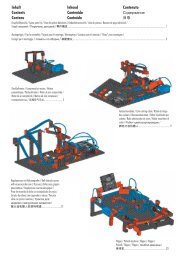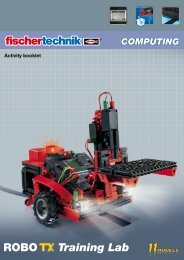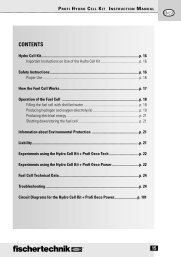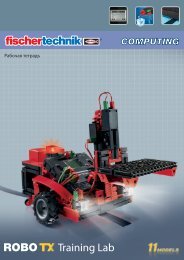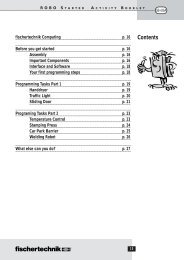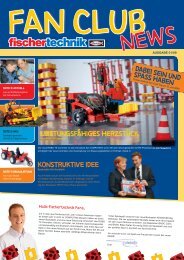2 Tech Rev GB - Fischertechnik
2 Tech Rev GB - Fischertechnik
2 Tech Rev GB - Fischertechnik
You also want an ePaper? Increase the reach of your titles
YUMPU automatically turns print PDFs into web optimized ePapers that Google loves.
P ROFI TECHNICAL REVOLUTIONS ACTIVITY BOOKLET<br />
The Inventor p. 14<br />
The Safety Elevator p. 15<br />
The Electric Motor p. 16<br />
The Generator p. 17<br />
The Helicopter p. 18<br />
The Windshield Wiper p. 19<br />
The Centrifugal Governor p. 20<br />
The Morse Telegraph p. 21<br />
The Cardan Shaft p. 22<br />
The Perpetuum Mobile p. 23<br />
The Hair Hygrometer p. 24<br />
13<br />
Contents
The Inventor<br />
Edison—<br />
The "Profi -Inventor"<br />
Incandescent light bulb from Heinrich Göbel<br />
Gray or Bell?<br />
The Reis telephone<br />
14<br />
P ROFI TECHNICAL REVOLUTIONS ACTIVITY BOOKLET<br />
■ Using this construction set, you can not only learn about the technical revolutions, but you can experience<br />
them live—things that have changed the world. Just put it together and try it out. When you do this,<br />
you can assume the role of the inventive tinkerer. Perhaps you will feel the touch of the ingenious spirit,<br />
which surrounded the inventor himself, while you are doing this.<br />
Come on get started, or you can learn some more about the people, who are behind the inventions, on<br />
this page.<br />
Inventions are all around you. Just take a close look at some things at home. The incandescent light bulb<br />
on the ceiling, the television in the living room, the telephone in the hallway; the refrigerator, the vacuum<br />
cleaner and so forth. Even letterpress printing had to be invented so that books were available in large<br />
numbers. Just the same as this activity booklet that you now have in your hands.<br />
Everything is really simple, you say? However, many of the ideas, which appear to be obvious to you today,<br />
had to be thought of fi rst.<br />
■ One of the people, who had a lot of ideas patented, was Thomas Alva Edison. Generally known as the<br />
inventor of the incandescent light bulb.<br />
During his lifetime, Edison amassed 2000 inventions and 1093 American patents. However, he didn't make<br />
all of these alone, but in his company with the help of many employees.<br />
Many inventions were only further developments of devices of other inventors. For example, including<br />
the light bulb. Did you know that? Basically, this was not his idea! But he did improve it to the extent<br />
that it became useful for everyday use. And above all, he had it patented right away. This is of course<br />
very important. There are many inventors that nobody talks about today because they did not have their<br />
invention patented. Or even worse—they simply did it too late.<br />
■ It is the year of 1860 and a physics teacher in Friedrichsdorf near Frankfurt am Main (Germany) has<br />
built a scientifi c demonstration object for his students. With a wooden model of an eardrum, he causes an<br />
electric circuit to vibrate. He transmits these vibrations by cable to a copper wire coil in a small wooden<br />
box, which makes the vibrations audible. In doing this, he succeeded as the fi rst person in constructing<br />
a functional electrical telephone connection; his name is Philipp Reis. Never heard anything about him?<br />
This is certainly due to the fact that he never applied for a patent for his device and also did not market<br />
it as a telephone.<br />
But an American did this about 15 years later. He learned about the device from Philipp Reis, developed it<br />
further and applied for a patent. Thus, Elisha Gray did it right. Have you ever heard anything about him—<br />
Elisha Gray, the inventor of the telephone? No? Well, in this case this was because he did it too late.<br />
Somebody was there before him and also applied for a patent for a telephone—just two hours earlier.<br />
His name was Alexander Graham Bell. Since then, he is considered to be the inventor of the telephone.<br />
And the strange thing about this is that the device, for which he applied for a patent at that time, didn't<br />
even work. Bell only found out that other people were working on a similar device and so he applied for<br />
a patent for his half-fi nished device as a precautionary measure.
P ROFI TECHNICAL REVOLUTIONS ACTIVITY BOOKLET<br />
■ Have you ever thought about what happens, when you are standing in an elevator and the bearer cable<br />
breaks, which is holding the elevator car?<br />
During an international industrial exhibition in New York, a man shocked<br />
the crowd, which had gathered, as he was standing high above on an<br />
elevator platform and cut the only bearer cable holding this platform. The<br />
platform only dropped a short distance before it came to a complete stop.<br />
The revolutionary new emergency brake of this clever master mechanic<br />
insured that the platform did not crash to the ground. "All safe, gentlemen!"<br />
announced the man.<br />
This took place in 1854 and the man on the elevator platform was Elisha<br />
Graves Otis, the founder and the namesake of the elevator company, which<br />
still exists to this day.<br />
Before this, no one liked to visit the upper fl oors of a building. With the<br />
development of the safety elevator, this trend was reversed. Rooms on<br />
the upper fl oors suddenly became "in" and the demand rose steadily. This<br />
accelerated the construction of high-rise buildings and thus changed the<br />
face of major cities. Skyscrapers became symbols for power and respect and continue to be a prominent<br />
feature of the cityscape to this day.<br />
As of today, you will now certainly enter an elevator with new feelings. Take a closer look at the keypad<br />
(or manufacturer's nameplate). If the name OTIS appears on this, then from now on you will certainly think<br />
about this courageous master mechanic from New York.<br />
Task<br />
Play with the rate of fall of the elevator car a little bit. First, let the rope slide through<br />
your fi ngers slowly and then fast. When is the emergency brake triggered? Why does it<br />
brake only when you let go of the rope suddenly?<br />
1800 1900 2000<br />
Invention of the safety elevator<br />
�Pull up the elevator ...<br />
... and then let go suddenly �<br />
15<br />
The<br />
Safety Elevator<br />
"All safe, gentlemen"<br />
Profi le<br />
Inventor<br />
Elisha Graves Otis<br />
(1811 - 1861)<br />
Place of Birth<br />
Halifax, Vermont, USA<br />
Profession<br />
Master mechanic<br />
Outstanding Achievement<br />
Invented the safety elevator
The Electric Motor<br />
+<br />
Schematic diagram<br />
�<br />
1819<br />
1821<br />
1822<br />
1834<br />
1837<br />
�<br />
16<br />
P ROFI TECHNICAL REVOLUTIONS ACTIVITY BOOKLET<br />
■ The electric motor was not invented all of a sudden: It had many "fathers" so to speak. First, important<br />
relations between electrical power and magnetism had to be recognized.<br />
Hans Christian Ørsted discovered that electricity can generate magnetism.<br />
Michael Faraday proved that electromagnetism moves in a circle around a wire. Without this effect, an<br />
electric motor would not rotate.<br />
Peter Barlow developed Barlow's Wheel, which is named after him. A sort of forerunner of the electric<br />
motor.<br />
The engineer, Hermann Jacobi, designed the fi rst technically usable motor. He installed the motor in<br />
a six-person ship and cruised across a river with 220 watts of power. This is the fi rst application of an<br />
electric motor in practice.<br />
The American, Thomas Davenport, received the fi rst patent in the world for an electric motor on February<br />
25, 1837. His motor powered several machines and a carriage.<br />
Faraday Barlow Jacobi Davenport<br />
■ When you build the model electric motor then insure that the magnet is directly under the coil and<br />
the ends of the wire of the coil are not bent. Otherwise the coil will not run smoothly and the motor will<br />
not work properly. When everything is assembled and connected and you push the coil a bit, you will be<br />
amazed at how it rotates like crazy and is seemingly driven by an invisible hand. Well okay, you already<br />
know that electricity and magnetism play a role here. But what exactly is happening here?<br />
The principle is actually very simple. When you have two magnets in your hand then you have certainly<br />
noticed that they repel each other or attract each other depending on how you hold them together. The<br />
effect here comes from the magnetic fi elds which surround every magnet. They have a direction of fl ow<br />
and thus determine a north pole and a south pole. Same poles repel each other and different poles attract<br />
each other. One magnet is built into the model (1). The other magnet is the coil, which becomes an electromagnet<br />
as soon as current fl ows through it. If you send electricity through the coil then this produces a<br />
magnetic fi eld (2) with a north and south pole. Same poles repel each other and so the coil tries to move<br />
away and because it can only rotate then it does just this. Before it rotates into the optimal condition, in<br />
which the different poles would be across from each other, we just cut off the electricity to the coil (look<br />
at the ends of the wire, they are only conducting to one half). However, using the momentum, which has
P ROFI TECHNICAL REVOLUTIONS ACTIVITY BOOKLET<br />
been attained, the coil rotates a bit further until it again receives electricity and the game starts from the<br />
beginning again.<br />
■ The electric motor and the generator are very similar machines, which are only operated as opposites.<br />
The electric motor produces a movement from electricity while the generator generates electricity from<br />
a rotational movement. Theoretically, you could also generate electricity with your electric motor model.<br />
However, in order to do this you would have to rotate the coil very very fast if you wanted to have a minilight<br />
bulb get even close to producing just a little bit of light. This works better with the generator model<br />
from the assembly instructions, which can produce a useful rotational speed thanks to the preceding<br />
gearbox. However, this is also only just suffi cient for a little light bulb. The biggest problem here is the<br />
weak magnet.<br />
Brainteaser<br />
Do it like Edison, take an existing invention and improve it:<br />
How can you solve the problem of a magnet, which is to weak? Do you know a magnet<br />
that you can make stronger? Go back to the previous chapter and look at the graphic<br />
there (schematic diagram). Two different magnets are described. Which one can you<br />
strengthen?<br />
Have you fi gured it out? Then you are just as clever as Werner Siemens. He<br />
had the same idea in 1866. Instead of permanent magnets, he installed<br />
electromagnets, which he ingeniously supplied with a part of the electricity,<br />
which was produced by the generator itself. In this way the mag- � �<br />
netic fi eld reinforces itself. More electricity -> more magnetic force -><br />
more electricity and so forth. This self-energizing is also called the "dynamo<br />
electric principle." In the graphic on the side, the coils of the electromagnets<br />
1 and 2 are clearly integrated into the electric circuit.<br />
With the dynamo, much stronger currents could be produced for the fi rst time and also cheaper than was<br />
previously possible. This was the start of electrical power engineering. A steadily increasing number of<br />
machines could now be effectively driven by electric power. Locomotives, elevators, street cars, mine<br />
tramways and works railways were equipped with electric motors and entire streets were brightly illuminated<br />
with power lights.<br />
First E-locomotive Elevator Street lighting First electric street car<br />
17<br />
The Generator<br />
and the Dynamo<br />
Beginning of Electrical<br />
Power Engineering<br />
Profi le<br />
Inventor<br />
Ernst Werner Siemens<br />
(1816 - 1892)<br />
Place of Birth<br />
Hanover, Germany<br />
Trained Profession<br />
Artillery Lieutenant<br />
Outstanding Achievement<br />
Invented the dynamo and is<br />
the founder of the presentday<br />
Siemens AG.
The Helicopter<br />
The Secret of Flight<br />
Profi le<br />
Inventor<br />
Henrich Focke (1890 - 1979)<br />
Place of Birth<br />
Bremen, Germany<br />
Profession<br />
Mechanical engineer<br />
Outstanding Achievement<br />
Designed and built the fi rst<br />
usable helicopter in the<br />
world.<br />
P ROFI TECHNICAL REVOLUTIONS ACTIVITY BOOKLET<br />
■ Heinrich Focke the helicopter pioneer. A restless<br />
researcher, who is fascinated by both technology and<br />
fl ying.<br />
He studied mechanical engineering in Hanover. In 1924, at<br />
the age of only 34, he founded the Focke-Wulf-Flugzeugbau<br />
AG in Bremen and in 1937 the fi rst helicopter factory in the<br />
world. By 1933, he had built about 140 fi xed wing aircraft.<br />
His aircraft were technically highly developed for the conditions<br />
at that time and easy to fl y. They were even so good<br />
that several fl ying records were made with them!<br />
In 1934, the time has come: The prototype of the fi rst really controllable helicopter lifts off, the FW61.<br />
Following this, came the fi rst usable helicopters in the world.<br />
18<br />
Wing Form and Lift<br />
Lift<br />
More lift<br />
The curvature of a wing diverts the airfl ow and in this way generates<br />
a force, which lifts an airplane upwards; this force is called lift. This<br />
is the secret of fl ight. Birds knew about this long before us. You can<br />
increase the lift by tilting the wing a little bit. The experts call this<br />
increasing the angle of attack. You can observe this clearly when<br />
commercial planes take off and land.<br />
So now lets move to the helicopter. In principle, this works in exactly<br />
the same way. The wings, which are called rotor blades here, have<br />
a profi le like a normal airplane. But how can the helicopter tilt the<br />
rotor blades? They are continually rotating and at a terrifi c speed!<br />
When you build the model, then you will have uncovered this secret<br />
as well.<br />
The process, which is used to change the angle of attack of the rotor blades together, is called the collective<br />
rotor blade adjustment.<br />
Mechanical Solution<br />
���<br />
The short term for the control of height (higher, lower) is als also so called<br />
the collective or pitch in the pilot's language. The collective e lever (1)<br />
is normally located to the left of the pilot's seat. If you move e the lever,<br />
then the collective rotor blade position (2) changes. This me means eans that the angle of attack<br />
(3) of all rotor blades changes and thus the lift changes. MMoving<br />
Moving the lever upwards =<br />
increasing the angle of attack = increasing lift. Or in more simple mple<br />
terms—the<br />
helicopter climbs.<br />
�<br />
�
P ROFI TECHNICAL REVOLUTIONS ACTIVITY BOOKLET<br />
■ It is a cold winter day in New York in the year 1902. A young<br />
woman is sitting in the street car and sees how the driver is<br />
driving with an open windshield to maintain good visibility during<br />
the prevailing freezing rain. She thinks "It must be possible<br />
to do this differently." She had a hand-operated<br />
device built, which kept the windshield clear, in a<br />
local shop according cccording<br />
to her sketches. The woman's<br />
name is Mary ary<br />
Anderson and she is the inventor<br />
of the windshield sshield<br />
wiper system. In principle,<br />
Excerpt from patent document from 1903<br />
this is a wiper pper<br />
arm, which is moved back<br />
and forth using ssing<br />
a lever in the inside of<br />
the street car.<br />
"We don't think that a profi table business can be made adde<br />
with this" was the comment of a well-known Canadian<br />
company, to which she offered her wiper. In 1920, the<br />
automobile industry took over the design as part of the<br />
standard equipment, however, Mary Anderson's patent t<br />
had already expired.<br />
Counter-rotating<br />
parallelogram wiper<br />
for example, example bus, bus bus, Porsche che 904<br />
904<br />
Task<br />
As the last of the three models, put the parallelogram wiper together.<br />
Imagine that you had invented the counter-rotating parallelogram wiper. You go with this<br />
to an auto manufacturer and he thinks the idea is really great and would like to buy the<br />
wiper from you—however, only if the wipers do not run counter to each other but<br />
with each other! Can you supply him with the wiper (modify)?<br />
(For the solution see the last page.)<br />
Profi le<br />
Inventor: Mary Anderson (1866 - 1953)<br />
Place of Birth: Greene County, Alabama, USA<br />
Profession: Building contractor, rancher, vintner<br />
Outstanding Outs O<br />
Achievement: Invented the windshield wiper system.<br />
19<br />
The Windshield<br />
Wiper<br />
Counter-rotating wiper<br />
for example, Mercedes-Benz, VW Sharan<br />
Synchronous wiper<br />
normal design for passenger cars
The Centrifugal<br />
Governor<br />
Profi le<br />
Inventor<br />
James Watt (1736 - 1819)<br />
Place of Birth<br />
Greenock, Scotland<br />
Profession<br />
Mechanic<br />
Outstanding Achievement<br />
Increased the effi ciency and<br />
safety of the steam engine.<br />
20<br />
P ROFI TECHNICAL REVOLUTIONS ACTIVITY BOOKLET<br />
■ First a small detail: James Watt did not basically invent the<br />
steam engine but signifi cantly improved the direct acting steam<br />
pump, which was developed by Thomas Newcomens in 1705. With<br />
this, he initiated the triumphant progress of the steam engine.<br />
1775: James Watt founded together with Matthew Boulton,<br />
the fi rst steam engine factory in the world in England. In 1788,<br />
Watt used the centrifugal governor for the fi rst time to maintain<br />
a constant working speed for the steam engine, which he had<br />
improved. Namely, if it runs too fast then it can easily happen that<br />
it destroys itself due to overloading or in other words it will blow<br />
up in your face. The centrifugal governor increased the reliability<br />
and thus promoted the spread of the use of the steam engine. Textile machines and water pumps were<br />
followed by steam locomotives, steam ships as well as locomobiles and trucks. In 1852, the fi rst airship<br />
was also powered by a steam engine. The industrial revolution—meaning the change of the working world<br />
and society by machines—was triggered by the spread of the use of the steam engine.<br />
In honor of James Watt, the unit of measure for power was named the watt.<br />
■ Now to the mode of operation of your model: Normally, the rotational movement of<br />
the steam engine is transmitted to the centrifugal governor, for example, with a<br />
belt. Since you likely don't have a steam engine readily available then you can<br />
simulate this simply by turning the small crank. When there is a stoppage of<br />
the machine then the centrifugal weights (1) are down and the fl ap (2) for<br />
the steam supply is fully open. If the machine gets steam and then starts<br />
to run then the centrifugal governor rotates and forces the centrifugal �<br />
weights to the outside. Due to this, the lifting<br />
�<br />
mechanism (3) slows the supply of steam and<br />
reduces the rotational speed. This occurs until<br />
a constant rotational speed is reached, a<br />
sort of equilibrium. Or more simply said<br />
the faster the machine<br />
runs the less steam that<br />
�<br />
is supplied to it.<br />
Task<br />
You want to soup it up a bit, tune it up or make the steam engine faster. To do this, you<br />
have an eye on the weights for the centrifugal governor. Do you have to make them<br />
heavier or lighter?<br />
�
P ROFI TECHNICAL REVOLUTIONS ACTIVITY BOOKLET<br />
■ Today, if you want to send a friend a message quickly then you call him up, write an e-mail or exchange<br />
information with a chat. In the past, you could only exchange information this fast with people sitting right<br />
beside you. A letter took, depending on the distance, a few days or even months.<br />
Later, as electricity could be used, the idea of sending signals through a cable was found. But how should the<br />
electrical signals be reproduced at the other end? Here, an American painter<br />
thought of a simple principle. He assigned a series of short and<br />
long current pulses to the various letters of the<br />
alphabet—by the way the computer<br />
today works in a very similar<br />
fashion but it uses a 1 and 0<br />
signal instead of the dash and<br />
dot. The signals were sent using a<br />
special switch and at the other end<br />
of the line these were written down as<br />
dashes or dots.<br />
The special switch is called the "Morse key"<br />
and the dash-dot assignment to the letters is<br />
called the "Morse code" after the inventor, Samuel Morse.<br />
■ Actually, Mr. Morse was a professor for painting, sculpture and drawing. In spite of this, he developed not<br />
only the Morse code, but in 1837 also the fi rst usable Morse telegraph. However, this was stuck together<br />
with scraps of wire, sheet scraps and a wall clock. Five years of experimentation were then necessary<br />
until the apparatus was ready for patenting. After his telegraph became successful, he founded his own<br />
telegraphy enterprise. Initially, telegraph lines were established between cities and countries and fi nally<br />
even between continents like Europe and America. For this purpose, a deep sea cable was laid across the<br />
Atlantic in 1858. Just imagine, what a long cable this was! At that time, there was no ship that was big<br />
enough for this. They then divided it and loaded it onto two ships and laid it starting from each continent<br />
and then put it back together on the high sea.<br />
Task<br />
What is the meaning of this string of characters: „ · · · - - - · · · “? (See solution below.)<br />
Think up individual words or entire sentences and key them into your Morse telegraph.<br />
Your friend can then read them from the light bulb.<br />
Tip: Get yourself a longer cable and then you can put the light bulb in another room. After you have practiced<br />
and are good at sending messages with Morse code, you can exchange secret messages with your<br />
friends at night using a fl ashlight.<br />
Solution for the task on this page: The emergency call SOS<br />
21<br />
The Morse<br />
Telegraph<br />
Telegraphy,<br />
the grandmother<br />
of the Internet<br />
The Morse Code<br />
a · - n - ·<br />
b - · · · o - - -<br />
c - · - · p · - - ·<br />
d - · · q - - · -<br />
e · r · - ·<br />
f · · - · s · · ·<br />
g - - · t -<br />
h · · · · u · · -<br />
i · · v · · · -<br />
j · - - - w · - -<br />
k - · - x - · · -<br />
l · - · · y - · - -<br />
m - -<br />
Wait · - · · ·<br />
Beginning · - · - · -<br />
End · · · - · -<br />
z - - · ·
The<br />
Cardan Shaft<br />
22<br />
P ROFI TECHNICAL REVOLUTIONS ACTIVITY BOOKLET<br />
■ If we didn't have this nondescript joint, nothing would turn in<br />
many areas of our everyday life.<br />
But fi rst let's start at the beginning.<br />
In 1501, a boy was born in Milan, who would later become<br />
very famous. It is the time of the Renaissance. It was called<br />
this because it was an age of awakening for art, science and society. Many artists and scientists such<br />
as Michelangelo, Galileo and Leonardo da Vinci and even Cardano made a name for themselves due to<br />
their extraordinary achievements. He was certainly the most famous doctor of his time because kings<br />
and princes were his patients. In addition, he was a mathematician and inventor. He made important<br />
discoveries concerning the theory of probabilities. However, before he wrote a book about this, he used<br />
the knowledge he acquired for gambling until he had earned enough money so that he could pay for his<br />
medical studies with this. As you have noticed, he was also clever.<br />
And now to the shaft, which was named after him.<br />
Problem: In drive technology, in most cases there is a motor and a machine, which is to be powered.<br />
Often, both elements are a certain distance away from each other, not at the same height or also move<br />
back and forth. If you would connect both with a rigid shaft then it would inevitably break. On the other<br />
hand, a soft fl exible shaft would be too weak to transmit large forces.<br />
Solution: A shaft that is fl exible as well as stabile. The propeller shaft with universal joints or the cardan<br />
shaft.<br />
Task<br />
Place the shaft in the various positions, turn the motor on and observe the movement,<br />
which the joint must make and in particular in a position, which involves signifi cant bending.<br />
Isn't it amazing how you can just bend a rotating movement around the corner?<br />
Test the limits. Hold the shaft on the grip, which cannot rotate with the movement, turn<br />
on the motor and carefully try to fi nd out how far you can bend the shaft.<br />
Agricultural machines Ship traffi c Vehicles Industry
P ROFI TECHNICAL REVOLUTIONS ACTIVITY BOOKLET<br />
■ Each year, the European Patent Offi ce is still receiving over 100 designs for machines, which once they<br />
are started, are to continue to rotate forever and a day. In this respect, so many people have already tried to<br />
design a "perpetual motion machine"— a perpetuum mobile and have been trying to do so for hundreds of<br />
years. In 748, for example, an Indian astronomer described his idea. Four hundred years later, a countryman<br />
of his, Bhaskar II, a mathematician, tried it. They were all bright people and even geniuses have brooded<br />
over this: In the 15th century, Leonardo da Vinci left sketches of a rotational solid motion machine. It is<br />
very similar to the model in your fi schertechnik construction set. Do it once like Leonardo da Vinci.<br />
Task<br />
First think about how it could work.<br />
What parts could provide the drive?<br />
Why should the building blocks, which are tilted down, rotate upwards?<br />
Then put the model together and put it motion with a vigorous shove.<br />
10 kg<br />
1 kg<br />
According to the lever principle, the building blocks (1), which project<br />
out further, ought to exert a stronger leverage on the rotary disk and<br />
th thus pull the building blocks (2), which are tilted downwards and have<br />
a<br />
shorter lever arm, upwards. It sounds real good. But<br />
wwhy<br />
doesn't it work in spite of this?<br />
■ After some attempts, Leonardo da Vinci came to the conclusion that a perpetuum<br />
mobile was not really solvable in a mechanical way. However,<br />
in 1845, a doctor, Julius Robert von Mayer, found out that this �<br />
was also not possible electrically, hydraulically or otherwise.<br />
While he was searching for the miracle apparatus himself, he<br />
came to a realization and he formulated it in a principle, the "principle of<br />
the preservation of energy:"<br />
In a closed system, no energy is lost, it is always only transformed.<br />
Therefore, energy such as kinetic energy cannot be<br />
created from nothing. Or to put it in less physical<br />
terms: Nothing comes from nothing. In the case<br />
of movement, some motive power is even "lost." Better<br />
said, it is transformed, for example, in friction and<br />
thermal energy. This is deducted from the kinetic energy<br />
and at the end there is always a standstill— just as is the<br />
case for your model.<br />
At the latest after this insight, the topic of perpetuum mobile is<br />
crossed off the list— at least from a scientifi c perspective.<br />
� �<br />
�<br />
23<br />
The Perpetuum<br />
Mobile<br />
The Dream of the<br />
Continuous Run Motor<br />
Model according to Leonardo da Vinci<br />
"Nothing comes<br />
from nothing"
The<br />
Hair Hygrometer<br />
Profi le<br />
Inventor<br />
Horace Bénédict de Saussure<br />
(1740 - 1799)<br />
Place of Birth<br />
Geneva, Switzerland<br />
Profession<br />
Naturalist, professor of<br />
philosophy<br />
Outstanding Achievement<br />
Invented the hygrometer.<br />
First to climb the little<br />
Matterhorn.<br />
24<br />
P ROFI TECHNICAL REVOLUTIONS ACTIVITY BOOKLET<br />
■ Horace-Bénédict de Saussure studied the natural sciences and<br />
was so good that at the age of only 22 he was appointed as professor<br />
for philosophy at the University of Geneva. However, he was<br />
not only a particularly clever fellow but also a real nature boy. His<br />
intellectual curiosity continually drove him to the mountains where<br />
he conducted scientifi c measurements. In 1787, he even conquered<br />
the highest mountain in the Alps, Mont Blanc at 4810 meters. At the<br />
summit, he measured among other things the boiling point of water,<br />
the snow temperature and the pulse of his mountain guide.<br />
In some cases, he invented the devices, which were needed for the measurements, himself such as the<br />
hygrometer. With this, you can measure the atmospheric humidity, which means the percentage<br />
of water vapor in the air. Rain drops, fog or snow are not part of this. You<br />
will certainly ask yourself what is the purpose of this?<br />
The atmospheric humidity has effects on our life.<br />
Low Atmospheric Humidity<br />
The laundry dries faster.<br />
The risk of catching a cold increases because<br />
the mucous membrane of the nose<br />
dries out.<br />
Fields dry out and plants wither.<br />
High Atmospheric Humidity<br />
The probability of rain increases.<br />
Increased risk of mold in apartments.<br />
At high temperatures, it creates sultriness and nausea.<br />
Task<br />
Set the indicator of your hygrometer to about the middle of the scale (1). To do this,<br />
use the sliding building block (2).<br />
Place a moist dish towel over your model, so that it is completely covered.<br />
After a few minutes, you can remove the towel.<br />
Where is the indicator now and why did it move in this direction?<br />
The indicator moved upwards. Under the towel the atmospheric humidity increased to a relative value of 95<br />
percent. The hygrometer fi ber absorbs the moisture and expands when it does this. When you remove the<br />
towel, the fi ber dries and becomes shorter. (You can accelerate the drying process using a hair dryer.)<br />
�<br />
�
Dank und Bildverzeichnis:<br />
Ein Dankeschön an folgende Institutionen für die<br />
freundliche Erlaubnis ihre Fotografi en abzudrucken.<br />
Dabei verwendete Abkürzungen bedeuten:<br />
M = Mitte; u = unten; l = links; r = rechts; o = oben<br />
OTIS GmbH & Co. OHG [3lo]<br />
Siemens press picture, Siemens AG [5u]<br />
www.oldskoolman.de [8o; 10u]<br />
Simon Eugster, www.granjow.net [9u]<br />
Lösung für einen gleichlaufenden Parallelogrammwischer:<br />
Solution for a synchronous parallelogram wiper:<br />
Solution pour un essuie-glace en parallélogramme synchronisé :<br />
Oplossing voor een gelijkbewegende parallellogramwisser:<br />
Solución para un limpiaparabrisas de paralelogramo de marcha sincronizada:<br />
Solução para um limpador de para-brisa de paralelogramo movendo-se na mesma direção:<br />
Thank you and index of diagrams:<br />
A thank you to the following institutions for the<br />
friendly permission to print their photographs.<br />
Meaning of abbreviations used for this:<br />
M = Middle u = below l = left r = right o = above<br />
OTIS GmbH & Co. OHG [3lo]<br />
Siemens Pressebild, Siemens AG [5u]<br />
www.oldskoolman.de [8o; 10u]<br />
Simon Eugster, www.granjow.net [9u]<br />
140 715 · 06/10 · Co · Printed in Germany · <strong>Tech</strong>nische Änderungen vorbehalten · Subject to technical modifi cations




